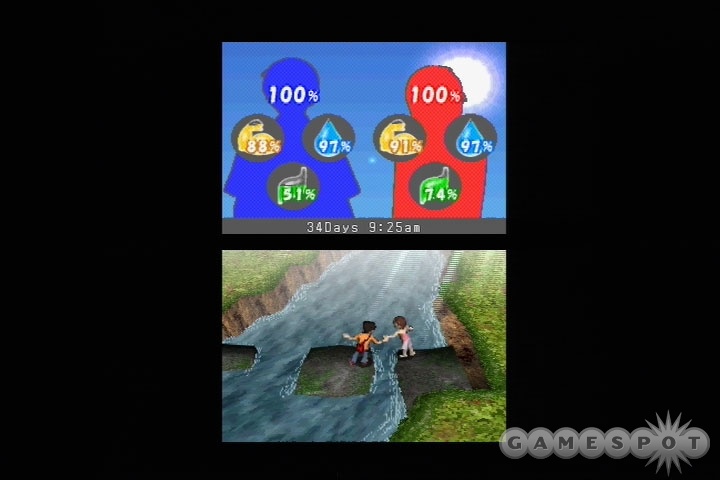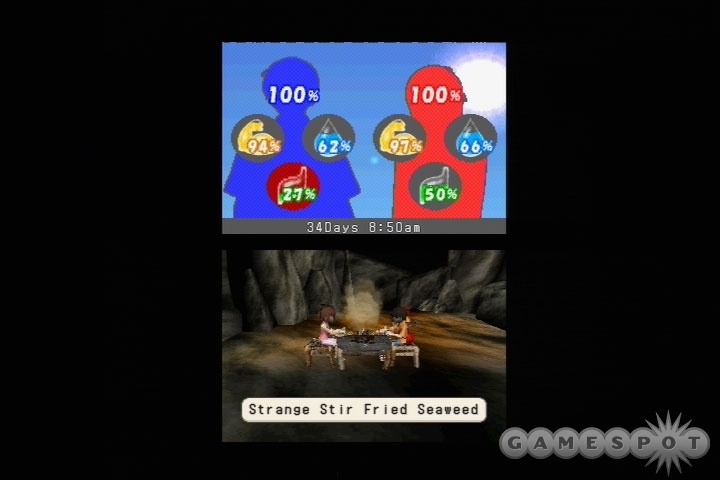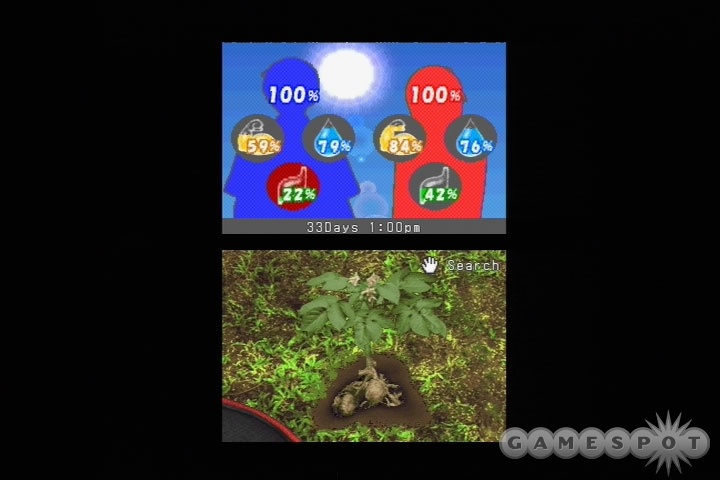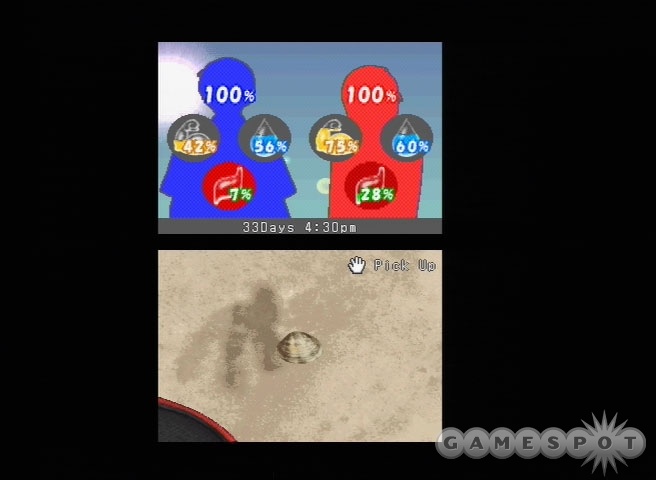It's not just reality TV show stars who're getting thrown into the wild without the benefit of modern amenities. Lost in Blue is an adventure based around survival, where you fight the unassuming and insidious enemies of hunger, thirst, exhaustion, and time. While some inventory and travel issues make eking out a living a shade more tedious than it really needs to be, at its best the game is an addicting exercise in the power of human perseverance.

You'll play as Keith, a senior in high school who's relishing his first solo trip of summer vacation right up until the point where the oceangoing ship he's on capsizes. He comes to on a deserted island and his only company is Skye, a young woman who's pretty blind after the tragic loss of her glasses. It's up to you to find a way to explore the island and eventually engineer your escape, while also keeping yourself alive. You'll need to collect food and water, build tools, and stockpile supplies of all kinds if you want to leave something for the rescue crews besides a pair of sun-bleached skeletons. In fact, with all the harvesting, hunting, digging, and organization you'll be doing, the experience ends up being much like a Harvest Moon game--a Harvest Moon game where you'll die horribly if you don't get out to pick the vegetables.
Just about everything you need on the island can be found lying around somewhere or other, and it's just a matter of roaming around to gather things up. Most items can simply be picked up, while in the case of certain foods, like clams or plants, you'll need to bend over and use the stylus to dig them out of the sand or the earth. There are even a few cases where you can "persuade" trees to drop you supplies by shaking them and hoping fruit or firewood falls out of them. A great deal of your time in the game is spent just gathering food, firewood, and other supplies, and then bringing them back to your humble cave abode where Skye can cook you a meal or weave you baskets and rope. Skye generally stays at home all of the time (without her glasses, she can't see where she's going and gets lost), though you can hold her hand and take her outside when you need to. However, getting her anywhere is a pretty big pain, as you have to manually haul her over ledges and logs, and she can't climb certain areas that Keith can.
You can chat with Skye while visiting the cave, and she often has a number of helpful hints about life on the island. Talking to her also triggers Keith's ability to build various kinds of furniture, as she suggests needed items for their crude home. While wandering the grasslands and jungles, you can find a couple of different items for Skye to serve food on, which will improve her cooking so meals will be more satisfying than they would be otherwise. Depending on the foods you give her to cook, she'll make a variety of different things with bizarre names, like freaky clam bake or mystery carrot salad, though she can also produce things with more pedestrian names, like baked potato.

Tools and items are also big necessities, from the crude fire-starter you craft at the very beginning to the furniture you can build to make cave-living a bit easier. You make tools by combining simple items you can find, like sharpening a rock into a stone point and then fastening it to a stick for a spear. Weapons like spears (and bows and traps) let you hunt some of the indigenous wildlife, and the fish, birds, and mammals are much more filling than the fruit and vegetables you find. Using a bow or spear brings up a close-up screen where you can aim and strike using the stylus, though the control here is a bit imprecise. Building furniture utilizes a minigame where you need to trace stylus gestures on the touch screen at certain times to accomplish a successful build. The thing is that these motions don't have much to do with the actual mechanics of building, so it ends up feeling like a gameplay gimmick to use the touch screen more than it immerses you in the joy of woodworking.
You need all these ample materials and food to keep your characters in tip-top shape. There are four main stats on Keith and Skye that you need to watch. The water gauge measures your thirst, the stomach gauge your hunger, the stamina gauge your energy, and the HP meter measures your life. Eating eases hunger, drinking eases thirst, and resting or sleeping replenishes your stamina. If you let any of those three main attributes drop to zero, you start to experience problems. When your stamina is zero, you won't be able to run and you'll have to crawl over the terrain. An empty stomach steadily saps your strength, and your character won't be able to sleep while hungry. An empty stamina or water gauge starts to drain your overall HP, and if your HP reaches zero, it's game over.

Time drains all of these stats (except for HP), and time passes at an accelerated rate compared to real time, so the weight of keeping your characters well-fed and rested is always hanging over your head. The day can start out just fine, but if you bring Keith too far into the surrounding jungle and allow him to exert himself too much, you can easily get yourself into a dangerous situation. Problems with Lost in Blue stem from the fact that you do need to invest so much time gathering food and such to keep your characters healthy, while also investigating the far reaches of the island and gathering supplies for necessary items, all of which has to be crammed into a backpack that can only hold 20 items at a time. This forces you to make many, many trips back and forth to various far-flung locales to gather items or do things that have to be done at a certain spot.
While you can eventually build a set of shelves for your cave that let you store some necessities when you go out harvesting, you still have to carefully manage your inventory when planning to visit other areas of the island. Keith's stamina is drained when he has to jump or climb, and getting to the farthest regions means a lot of costly, and time-consuming, scrambling. There are hardly any shortcuts, so you'll wear the same path smooth multiple times. Still, it can be said that even these issues tie into the "realism" of the game. For example, if you went on a long hike, you'd need to decide what you could pack to sustain you along the way.
The game can be pretty long depending on how good you are at hunting and harvesting, but you can generally finish in about eight to 10 hours. Beating the game unlocks a new mode where you can play as Skye and ply her cooking skills and find delectable recipes. There's even a third mode you can unlock after getting through Skye's scenario. So, there's a good amount of content you can squeeze out of it all.
The graphics are all 3D in the bottom screen, and the top screen is used to toggle between Keith and Skye's health, an area map, or an overhead view of the island that shows the general layout. The 3D figures have simple, limited animations but are put together well, and the island environments are varied, from jungle to a lake, to stretches of beach, to some mysterious ruins. The areas are well-organized and free of clutter, so there's a good amount of detail, but nothing that gets in your way when trying to locate items or move around. The tunes you'll hear playing all sound good for the most part, though one or two are a little low in the bit rate department. The characters have a smattering of phrases and expressions that are also utilized well.

Lost in Blue isn't a perfect extension of the Harvest Moon brand of Zen--it's marred by some inventory-juggling and lots of sometimes-tedious backtracking. Still, it's a fun little journey into the land of the lost that does a good job of making you realize that true survival is a bit more complicated when you can't just vote yourself off the island.